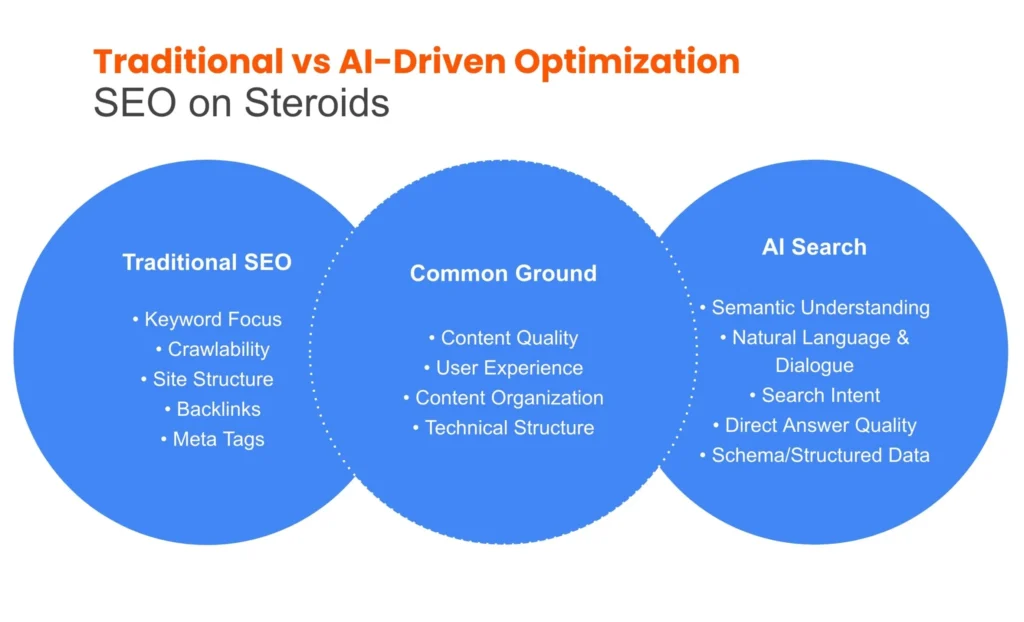Search is evolving faster than ever. With the rise of AI search engines, LLM-powered assistants, and conversational results, traditional SEO is no longer enough. Platforms like Google Search Generative Experience (SGE), Bing CoPilot, Perplexity, ChatGPT Search, and AI-driven search bars across the web rely on understanding, not just indexing.
This shift means that simply stuffing keywords or ranking for blue links is outdated. To get discovered today, your content must be:
- Machine-understandable
- Context-rich
- Highly authoritative
- Accurate and trustworthy
- Optimized for zero-click answers and AI summaries
In this guide, WaffleBytes breaks down exactly how to optimize your content for AI-driven search and discovery in 2025 with practical strategies you can apply today.
What Is AI Search and Why It Matters
AI search engines use natural language processing (NLP) and large language models (LLMs) to understand search queries at a deeper level. They don’t just match keywords they analyze intent, meaning, context, behavior patterns, and entities.
AI search powers:
- Google SGE (AI-generated answers)
- Perplexity.ai (conversational research)
- ChatGPT Search result summaries
- Bing Chat/Copilot results
- Voice assistants (Alexa, Siri, Google Assistant)
Unlike traditional search engines, AI assistants can:
- Give answers directly
- Summarize multiple sources
- Cross-verify facts
- Suggest actions
- Cite multiple websites
This means your content needs to be optimized to be selected as a source for these AI answers.

How AI Search Evaluates Content
Traditional SEO uses ranking factors.
AI search uses content understanding factors.
These include:
Semantic Understanding
AI focuses on meaning, relationships, and connections between words, not just exact keywords.
Entity Recognition
People, places, brands, products, and concepts need to be clearly defined and consistent so AI models understand them.
Trust and Accuracy
AI systems pull data from reliable, clearly sourced, and factual content.
Structure and Clarity
The easier your content is to interpret, the higher its chance of being chosen for AI-generated answers.
Topical Authority
AI models prefer websites with depth, not just single articles on a topic.
Conduct Keyword Research for AI Search
AI search is heavily intent-driven. That means the old method of picking single keywords doesn’t work anymore. You must think in questions, problems, conversational queries, and semantic variants.
Optimize for Question-Based Queries
Examples:
- “How does influencer marketing work in 2025?”
- “Best CRM tools for small businesses?”
- “What is schema markup and why is it important?”
These questions feed AI models directly.
Identify Conversational Long-Tail Keywords
AI search engines prefer conversational tone queries like:
- “Which email marketing tool is best for beginners?”
- “How to fix slow website speed easily?”
Use Semantic Keyword Tools
Tools like:
- Google People Also Ask
- Google Autocomplete
- AnswerThePublic
- AlsoAsked
- Semrush Keyword Clusters
These reveal related meanings, not just exact keyword matches.
Write Content for AI Understanding (Not Just Humans)
AI search engines select content that is:
- Clear
- Well-structured
- Accurate
- Detailed
- Easy to summarize
Here’s how to achieve that:
Use Clear, Direct Language
Avoid fluff or overly creative wording.
AI prefers clarity, such as:
“Crafting a mesmerizing digital identity…”
“How to build your online brand effectively…”
Use Short Sentences
AI models read thousands of articles. Short sentences help accuracy.
Add Definitions Early
If your topic includes jargon or complex ideas, define them immediately.
Example: “Semantic SEO is a strategy where you optimize content based on meaning, context, and entities rather than keywords.”
Build Information Hierarchy
Use this structure:
- H1: Main topic
- H2: Subtopics
- H3: Steps / breakdown / examples
- Bullet points
- Short paragraphs
AI models rely on headings and structure to create summaries.
Use Schema Markup for AI Readability
Schema is critical for AI search because it turns content into structured, machine-readable data.
Important schema types for AI optimization:
- Article Schema
- FAQ Schema
- HowTo Schema
- Product Schema
- Organization Schema
- LocalBusiness Schema
- Breadcrumb Schema
Google’s AI systems rely heavily on structured data to interpret meaning.
WaffleBytes strongly recommends adding JSON-LD schema for every important page.
Build Topical Authority (AI’s #1 Ranking Signal)
AI search prefers websites that demonstrate depth, not just surface-level content.
Create Topic Clusters
Example:
Topic: Instagram Marketing
Cluster Includes:
- Instagram SEO
- Reels strategy
- Hashtags guide
- Growth tactics
- Ads strategy
- Case studies
- Analytics and insights
AI sees this as a complete knowledge graph and trusts your site more.
Interlink All Related Pages
Internal links help AI understand relationships.
Publish Regular Updates
AI search rewards fresh, accurate content.
Include Author Expertise
Add:
- real names
- credentials
- bio
- links to profiles
It builds trustworthiness essential for AI algorithms.
Optimize Content for AI Summaries and Snippets
AI search engines generate answers in a summary form.
To be included, your content must be extremely “summarizable.”
Add 1–2 Sentence Answers at the Start
Example:
Question: “What is AI content optimization?”
Answer: “AI content optimization is the process of creating content that AI search engines and LLMs can easily understand, categorize, and pull into answer summaries.”
Use FAQ Sections
AI assistants pull FAQ answers directly from your content.
Provide Step-by-Step Lists
AI loves ordered steps:
- Identify user intent
- Build structured headings
- Add schema markup
- Optimize entities
- Include authoritative sources
Use Tables and Comparisons
AI systems extract data from tabular formats more easily.
Strengthen E-E-A-T for AI Selection
AI search models prioritize content with Experience, Expertise, Authoritativeness, Trustworthiness (E-E-A-T).
Ways to boost E-E-A-T:
- Add author bios
- Use credible external sources
- Cite research papers or verified stats
- Publish case studies
- Add testimonials or awards
- Write from real experience
- Maintain brand consistency
AI models favor trustworthy, high-authority content and ignore websites without author transparency.
Optimize for Voice Search and AI Assistants
AI discovery heavily overlaps with voice search.
Voice search optimization tips:
- Add conversational answers
- Keep sentences short
- Answer “who, what, why, when, how” queries
- Include local keywords (“near me”)
- Add schema markup for local business
Voice-based assistants like Siri and Alexa read content almost exactly like AI search engines.
Improve Technical SEO for Better AI Crawling
AI search still depends on technical factors.
Essential technical checks:
- Fast page speed
- Mobile responsiveness
- Clean URL structures
- XML sitemaps
- Robots.txt optimization
- No index bloat
- Secure HTTPS
- Minimal code errors
- Compressed images
- Avoid keyword cannibalization
Google and AI crawlers prefer well-maintained, fast, and accessible websites.
Optimize Content for Zero-Click Search
AI search often gives the answer directly.
This is called zero-click search.
To stay relevant:
Use unique insights
AI rarely replaces pages with original insights or case studies.
Offer downloadable assets
Examples:
- templates
- checklists
- tools
- calculators
Encourage deeper exploration
Use CTA elements like:
- “See full case study”
- “Explore complete guide”
- “Download free toolkit”
Monitor AI Search Performance
Google Search Console now includes SGE visibility metrics.
Other tools also help:
- Semrush
- Ahrefs
- Surfer SEO
- MarketMuse
- NeuronWriter
- Perplexity source tracking
Track:
- Pages appearing in AI overviews
- Query topics triggered
- Featured snippets
- CTR changes
- Keyword clusters
- Topical authority scores
AI search is not the future, it’s the present.
The way people discover content is shifting from keyword matching to meaning-based search, entity recognition, and AI-generated summaries.
To stay ahead in 2025 and beyond, your content must be:
- Highly structured
- Semantically rich
- Trustworthy
- Machine-readable
- Expert-driven
- Summarizable
By following the strategies above, WaffleBytes (and your clients) can ensure their content is fully optimized for AI search engines driving more visibility, authority, and conversions than ever before.
AI search optimization is a strategy that makes your content understandable to AI models and search engines using semantic SEO, structured data, and topical authority.
No. AI search still relies on SEO fundamentals, but it demands deeper context, cleaner structure, and stronger authority.
Schema makes your content machine-readable, improving your chance of being included in AI-generated answers and rich snippets.
Content that is accurate, structured, expert-driven, and easy to summarize performs the best.
Yes. Pages selected for AI answers or summaries often see higher visibility, credibility, and click-through rates.

